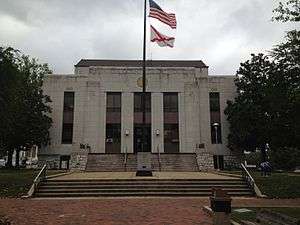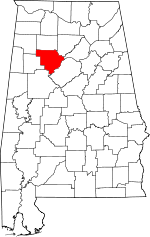Walker County, Alabama
Walker County is a county located in the central portion of the U.S. state of Alabama.[1] As of the 2010 census, the population was 67,023.[2] Its county seat is Jasper.[3] Its name is in honor of John Williams Walker, a member of the United States Senate.[1]
Walker County | |
|---|---|
 Walker County Courthouse in Jasper | |
 Location within the U.S. state of Alabama | |
 Alabama's location within the U.S. | |
| Coordinates: 33°48′13″N 87°17′52″W | |
| Country | |
| State | |
| Founded | December 26, 1823[1] |
| Named for | John Williams Walker |
| Seat | Jasper |
| Largest city | Jasper |
| Area | |
| • Total | 805 sq mi (2,080 km2) |
| • Land | 791 sq mi (2,050 km2) |
| • Water | 14 sq mi (40 km2) 1.7%% |
| Population (2010) | |
| • Total | 67,023 |
| • Estimate (2019) | 63,521 |
| • Density | 83/sq mi (32/km2) |
| Time zone | UTC−6 (Central) |
| • Summer (DST) | UTC−5 (CDT) |
| Congressional district | 4th |
| Website | www |
| |
Walker County is included in the Birmingham-Hoover, AL Metropolitan Statistical Area.
History
Walker County was established on December 26, 1823, and formed from sections of Marion and Tuscaloosa counties.[1] It was named after Senator John Walker, who represented Alabama in the U.S. Senate from 1819 to 1822.[1] The county was greatly reduced in size on February 12, 1850, when its northern half became the county of Winston. Jasper is the county seat, named after William Jasper, a Revolutionary War hero from South Carolina.[1]
National Register of Historic Places
Walker County has sites listed on the National Register of Historic Places. They include the Bankhead House, Boshell's Mill, the First United Methodist Church of Jasper, the Gilchrist House, the Jasper Downtown Historic District, the Stephenson House, and Walker County Hospital.[4]
Geography
According to the U.S. Census Bureau, the county has a total area of 805 square miles (2,080 km2), of which 791 square miles (2,050 km2) is land and 14 square miles (36 km2) (1.7%) is water.[5] The county is located in the Cumberland Plateau region, with many plateaus and valleys, along with many forested areas, covering the county.[6]
Adjacent counties
- Winston County (north)
- Cullman County (northeast)
- Blount County (east)
- Jefferson County (southeast)
- Tuscaloosa County (southwest)
- Fayette County (west)
- Marion County (northwest)
Demographics
| Historical population | |||
|---|---|---|---|
| Census | Pop. | %± | |
| 1830 | 2,202 | — | |
| 1840 | 4,032 | 83.1% | |
| 1850 | 5,124 | 27.1% | |
| 1860 | 7,980 | 55.7% | |
| 1870 | 6,543 | −18.0% | |
| 1880 | 9,479 | 44.9% | |
| 1890 | 16,078 | 69.6% | |
| 1900 | 25,162 | 56.5% | |
| 1910 | 37,013 | 47.1% | |
| 1920 | 50,593 | 36.7% | |
| 1930 | 59,445 | 17.5% | |
| 1940 | 64,201 | 8.0% | |
| 1950 | 63,769 | −0.7% | |
| 1960 | 54,211 | −15.0% | |
| 1970 | 56,246 | 3.8% | |
| 1980 | 68,660 | 22.1% | |
| 1990 | 67,670 | −1.4% | |
| 2000 | 70,713 | 4.5% | |
| 2010 | 67,023 | −5.2% | |
| Est. 2019 | 63,521 | [7] | −5.2% |
| U.S. Decennial Census[8] 1790–1960[9] 1900–1990[10] 1990–2000[11] 2010–2018[2] | |||
At the 2000 census there were 70,713 people, 28,364 households, and 20,478 families living in the county. The population density was 89 people per square mile (34/km2). There were 32,417 housing units at an average density of 41 per square mile (16/km2). The racial makeup of the county was 92.15% White, 6.17% Black or African American, 0.28% Native American, 0.20% Asian, 0.02% Pacific Islander, 0.31% from other races, and 0.86% from two or more races. Nearly 0.86% of the population were Hispanic or Latino of any race.[12] In 2000 the largest reported ancestry groups in Walker County, AL were:
- American 27.7%
- Irish 8.8%
- English 6.8%
- African American 6.17%
- German 3.9%
- Scottish 1.4%
- Scotch-Irish 1.4%
There were 28,364 households, 30.70% had children under the age of 18 living with them; 56.30% were married couples living together, 11.90% had a female householder with no husband present, and 27.80% were non-families. 25.30% of households were made up of individuals, and 11.20% were one person aged 65 or older. The average household size was 2.46, and the average family size was 2.93.
The age distribution was 23.50% under the age of 18, 8.60% from 18 to 24, 28.00% from 25 to 44, 25.10% from 45 to 64, and 14.80% 65 or older. The median age was 38 years. For every 100 females, there were 93.20 males. For every 100 females age 18 and over, there were 89.80 males.
The median household income was $29,076 and the median family income was $35,221. Males had a median income of $31,242 versus $20,089 for females. The per capita income for the county was $15,546. About 13.20% of families and 16.50% of the population were below the poverty line, including 21.00% of those under age 18 and 17.40% of those age 65 or over.
2010 census
At the 2010 census there were 67,023 people, 26,571 households, and 18,741 families living in the county. The population density was 85 people per square mile (33/km2). There were 30,816 housing units at an average density of 38 per square mile (15/km2). The racial makeup of the county was 91.2% White, 5.9% Black or African American, 0.4% Native American, 0.3% Asian, 0.1% Pacific Islander, 1.0% from other races, and 1.2% from two or more races. Nearly 2.0% of the population were Hispanic or Latino of any race.[13] There were 26,571 households, 26.8% had children under the age of 18 living with them; 52.0% were married couples living together, 13.3% had a female householder with no husband present, and 29.5% were non-families. 25.8% of households were made up of individuals, and 11.2% were one person aged 65 or older. The average household size was 2.49, and the average family size was 2.97.
The age distribution was 22.5% under the age of 18, 8.1% from 18 to 24, 24.4% from 25 to 44, 28.7% from 45 to 64, and 16.3% 65 or older. The median age was 41.2 years. For every 100 females, there were 95.1 males. For every 100 females age 18 and over, there were 97.8 males.
The median household income was $37,191 and the median family income was $45,788. Males had a median income of $43,671 versus $27,662 for females. The per capita income for the county was $20,516. About 14.7% of families and 18.6% of the population were below the poverty line, including 27.5% of those under age 18 and 12.4% of those age 65 or over.
Government
| Year | GOP | Dem | Others |
|---|---|---|---|
| 2016 | 82.3% 24,266 | 15.3% 4,497 | 2.4% 709 |
| 2012 | 75.7% 21,651 | 22.9% 6,557 | 1.3% 377 |
| 2008 | 72.3% 20,722 | 25.9% 7,420 | 1.8% 510 |
| 2004 | 67.6% 19,167 | 31.8% 9,016 | 0.7% 184 |
| 2000 | 52.6% 13,486 | 45.3% 11,621 | 2.1% 534 |
| 1996 | 39.4% 9,837 | 51.8% 12,929 | 8.7% 2,173 |
| 1992 | 38.3% 11,301 | 50.2% 14,831 | 11.5% 3,402 |
| 1988 | 48.5% 11,011 | 50.0% 11,338 | 1.6% 351 |
| 1984 | 54.1% 12,852 | 44.6% 10,591 | 1.3% 310 |
| 1980 | 38.5% 8,795 | 59.7% 13,616 | 1.8% 417 |
| 1976 | 31.2% 7,389 | 68.5% 16,232 | 0.4% 89 |
| 1972 | 78.8% 14,581 | 20.1% 3,724 | 1.1% 202 |
| 1968 | 13.6% 2,628 | 10.2% 1,971 | 76.3% 14,786 |
| 1964 | 58.4% 8,582 | 41.6% 6,110 | |
| 1960 | 40.3% 5,463 | 59.8% 8,109 | 0.0% 0 |
| 1956 | 40.1% 5,179 | 59.3% 7,661 | 0.6% 79 |
| 1952 | 33.5% 3,490 | 65.8% 6,862 | 0.8% 80 |
| 1948 | 30.7% 1,852 | 69.3% 4,176 | |
| 1944 | 32.5% 2,241 | 66.9% 4,619 | 0.7% 47 |
| 1940 | 25.2% 2,007 | 74.5% 5,940 | 0.3% 24 |
| 1936 | 22.7% 1,699 | 76.1% 5,697 | 1.2% 88 |
| 1932 | 24.9% 1,583 | 74.3% 4,734 | 0.9% 54 |
| 1928 | 46.2% 3,635 | 53.8% 4,228 | 0.0% 0 |
| 1924 | 39.9% 2,446 | 54.6% 3,351 | 5.6% 341 |
| 1920 | 47.8% 4,488 | 50.0% 4,703 | 2.2% 208 |
| 1916 | 43.3% 1,860 | 53.8% 2,314 | 3.0% 127 |
| 1912 | 24.6% 881 | 57.7% 2,063 | 17.7% 631 |
| 1908 | 44.7% 1,367 | 53.3% 1,632 | 2.0% 62 |
| 1904 | 37.9% 1,024 | 60.7% 1,639 | 1.4% 39 |
Transportation
Major highways
.svg.png)











Communities
Cities
- Carbon Hill
- Cordova
- Dora
- Jasper (county seat)
- Sumiton (partly in Jefferson County)
Unincorporated communities
Places of interest
Walker County is home to the William B. Bankhead National Forest and Lewis Smith Lake, in addition to the Alabama Mining Museum.
See also
References
- "ACES Walker County Office" (links/history), Alabama Cooperative Extension System (ACES), 2007, webpage: ACES-Walker.
- "State & County QuickFacts". United States Census Bureau. Retrieved May 17, 2014.
- "Find a County". National Association of Counties. Retrieved June 7, 2011.
- "National Register Information System". National Register of Historic Places. National Park Service. July 9, 2010.
- "2010 Census Gazetteer Files". United States Census Bureau. August 22, 2012. Retrieved August 22, 2015.
- http://www.encyclopediaofalabama.org/article/h-1185
- "Population and Housing Unit Estimates". Retrieved May 18, 2019.
- "U.S. Decennial Census". United States Census Bureau. Retrieved August 22, 2015.
- "Historical Census Browser". University of Virginia Library. Retrieved August 22, 2015.
- Forstall, Richard L., ed. (March 24, 1995). "Population of Counties by Decennial Census: 1900 to 1990". United States Census Bureau. Retrieved August 22, 2015.
- "Census 2000 PHC-T-4. Ranking Tables for Counties: 1990 and 2000" (PDF). United States Census Bureau. April 2, 2001. Retrieved August 22, 2015.
- "U.S. Census website". United States Census Bureau. Retrieved May 14, 2011.
- "U.S. Census website". United States Census Bureau. Retrieved 2015-08-13.
- "Dave Leip's Atlas of U.S. Presidential Elections". Retrieved November 21, 2016.
External links
- Walker County map of roads/towns (map © 2007 Univ. of Alabama).
